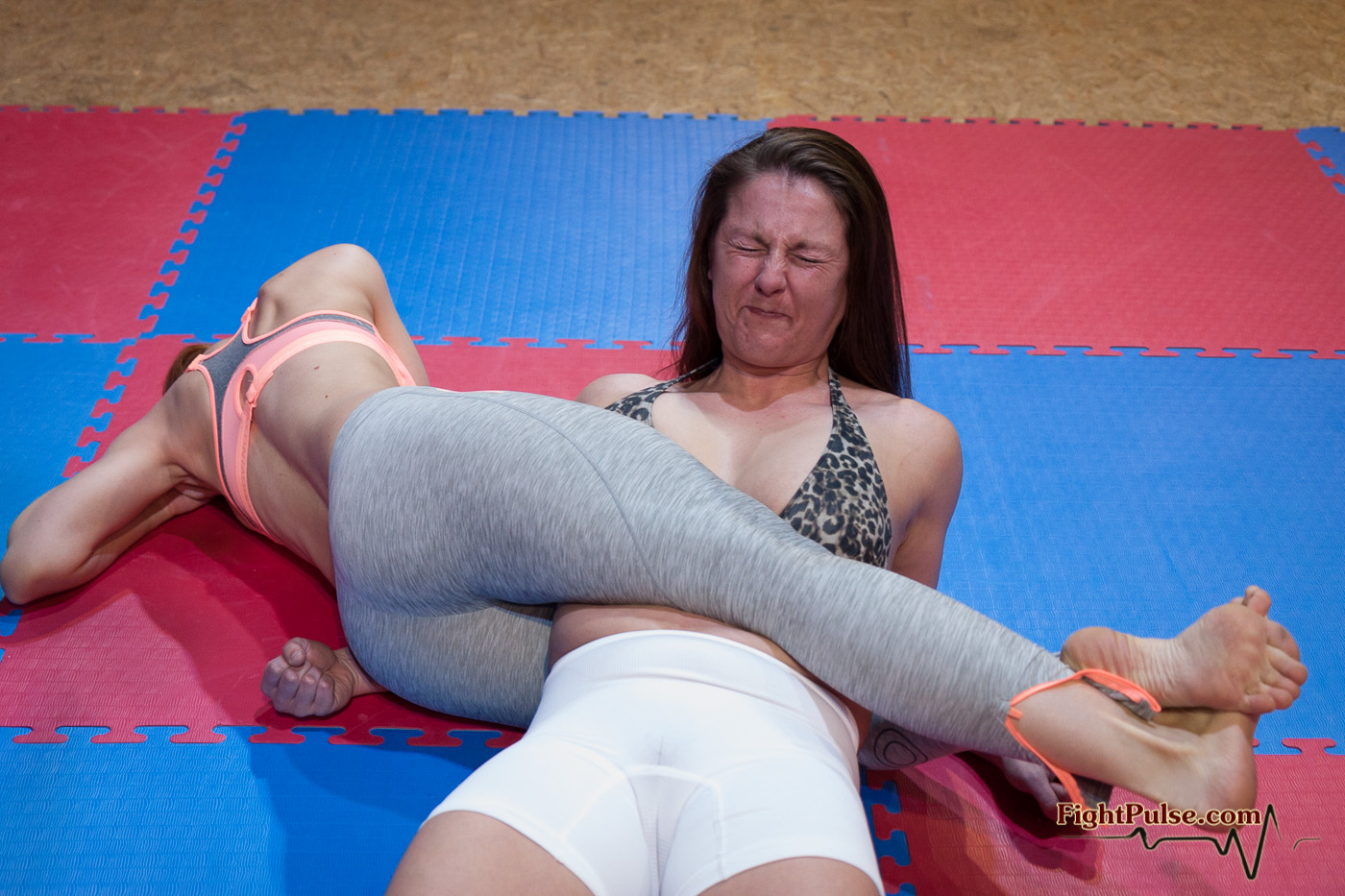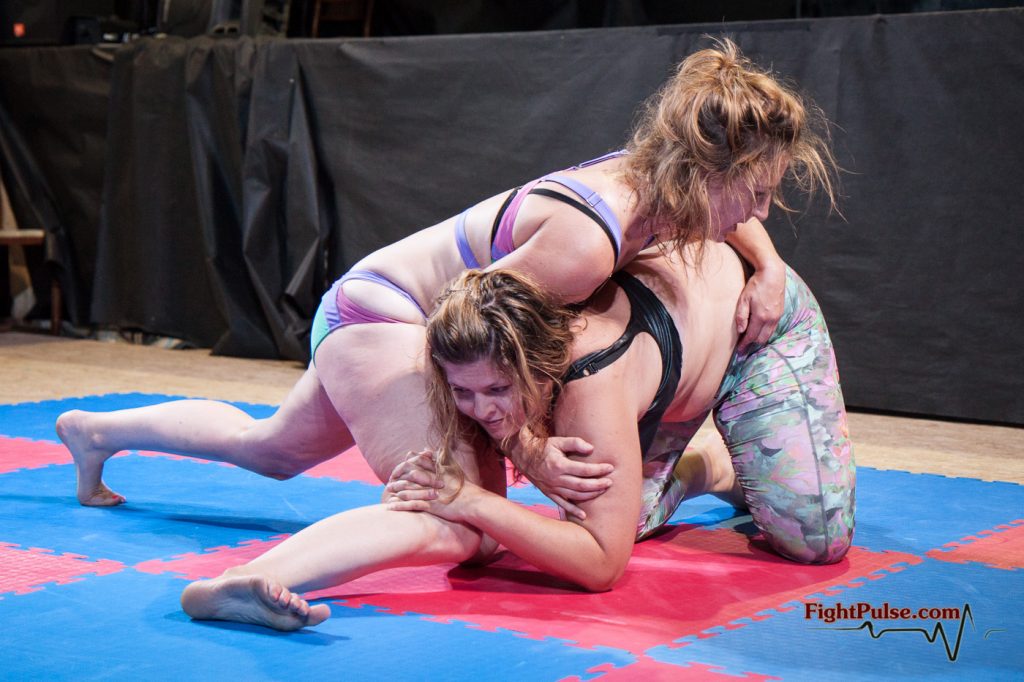
fciwomenswrestling.com article, fightpulse.com photo
Dynamics of competitive engagement can be altered to your advantage more often before the match begins than during.
The competitive female submission wrestling industry is seeing an increase in the number of matches involving larger beautiful Fem Competitors, often verses smaller ones.
If you are a smaller framed female athlete who will have to face a larger opponent on the mats, the key to success is what you can do before hand as opposed to during.
Let’s take a brief look at the trend.
LUCRECIA
We’ve recently purchased two of Lucrecia’s matches at the industry leader Fight Pulse and the more we watch her the more we love her. That of course is essentially from a fan’s perspective but the other aspect to her matches is that she has a strong advantage over her smaller opponents.
Let’s listen in on two of her matches against smaller opponents.
NC-40: Lucrecia vs Laila (scissors domination)

“Lucrecia takes charge in this custom-request wrestling match over Laila. The ruleset for this onslaught-style (no rounds) NC match is simple – only scissors submissions are allowed, and only verbal submissions are accepted. Or are they?
Turns out, not every time. Lucrecia clearly enjoys the desperate squirming of her victim between her legs, ignoring her verbal submissions time after time. A beautiful dominant performance by Lucrecia will not disappoint her fans, or fans of head scissors and body scissors in general, as NC-40 features very long humiliating scissor sequences.
If you are a fan of prolonged jaw-crushing breath-taking scissors holds and verbal humiliation along with it, this title is for you!”
https://www.fightpulse.com/non-competitive-wrestling/nc-40-lucrecia-vs-laila/
FW-14: Scorpion vs Lucrecia

“One of Fight Pulse’s best wrestlers Lucrecia (6′ 0″, 216 lb.) faces our guest, up-and-coming grappler from UK, Scorpion (5′ 7″, 154 lb.), in a competitive wrestling match. Scorpion compensates for her size disadvantage with agility and spectacular offensive game. She is on the attack all throughout the video. The winner in this match is determined not so much by the skill level of the winner, but by her sheer will to win. As it often happens, the wrestler who wants it more wins the match. Even though there is a decisive winner, this encounter is far from being one-sided. FW-14 features a variety of wrestling holds (and surprisingly, two reverse face sit pins), all of which are listed as tags below this title.”
https://www.fightpulse.com/female-wrestling/fw-14-scorpion-vs-lucrecia/
And another.
HH-04: Lucrecia vs Jane

https://www.fightpulse.com/head-to-head/hh-04-lucrecia-vs-jane/
Three times is a charm.
FW-07: Lucrecia vs Xena (head scissors match)

https://www.fightpulse.com/female-wrestling/fw-07-lucrecia-vs-xena-headscissors-match/
These matches are completed but it begs the question, what can a smaller competitor do before hand to give her a fighting chance in a weight and size disadvantaged match?
It’s fairly simple.
She needs to get into the weight room with a plan. As a smaller female wrestler, whatever you decide, you need to get stronger.
We have a guest writer who provides you with some suggestions, especially if you are strong on desire, yet short on time and size.
Yes, there is a doctor in the house.
How to Become Very Strong in 30 Minutes a Week
Some body builders lift weights for more than six hours a day, but you don’t have to waste that much time to become very strong. Training for weight lifting is done in sets. A set of ten means that you lift and lower a heavy weight ten times continuously before you rest. If you repeat these sets of ten three times with a rest period between each set, you have done three sets of ten.
Pick 6 to 10 weight-machine exercises and do them in three sessions a week. In each exercise, try to lift the heaviest weight that you can lift comfortably ten times in a row without hurting yourself. When an exercise becomes easy, increase the weight. In five months, you should be able to increase your strength significantly and be proud of your larger muscles.
You now decide that you want to become even stronger. Would you increase your strength more by increasing the number of repetitions or by increasing the weight that you lift? For example, should you try to do three sets of ten for each exercise or stay at one set of ten, just try to lift a heavier weight once a week? Dr. Michael Pollock of the University of Florida in Gainesville divided recreational weight lifters into two groups. In one group, they tried to do three sets of 10 three times a week. In the other group, they did just one set of 10 three times a week, but tried to lift progressively heavier weights. Those who did one set of ten with heavier weights three times week were stronger than those who did three sets of ten without increasing the weight.
The single stimulus to make muscles larger and stronger is to stretch them while they contract. When you try to lift a heavy weight, your muscles stretch before the weight starts to move. The greater the stretch, the greater the damage to the muscle fibers and when they heal after a few days, the greater the gain in strength. The results of this study give a clear message. You become stronger by lifting heavier weights, not by exercising more. If you do too much work, you can’t lift very heavy weights and you do not become stronger. When it comes to becoming very strong, less is more.
Most competitive bodybuilders spend hours trying to do many sets over and over again. You don’t need to do that. Various studies show that you can gain up to 80 percent of your maximum strength by picking out four to eight specific lifts, lifting one set of ten of the heaviest weight in each, and repeating your program twice a week. The reduced workload causes fewer injuries and leaves you with a lot of extra time to do other things.
Lowering a weight slowly, called negative lifting, is a greater stimulus to make you stronger than raising it. You can lower much heavier weights than you can lift. As you raise a weight, you have to slow down because gravity works against you so that the weight feels heavier as you continue to raise it. On the other hand, when you lower a weight, you tend to move faster as gravity works with you and the weight feels lighter.
This negative lifting workout should be done only by experienced lifters not more often than once a week. Pick 10 to 15 lifts that you do regularly. Start out by lifting the heaviest weight that you can lift ten times in a row. You will struggle to get through the last three or four lifts. Then add five to 15 pounds, which may be too heavy for you to lift. Two spotters should lift the weight for you and you try to lower it six times. You’ll really hurt and you may want to quit. Add another ten pounds and try to lower the weight three times. Then pick your arms off the floor, replace them on your shoulders and take at least two days off.
Lifting weights enlarges your muscles and makes you stronger, but it does not make you fit. Fitness refers to your heart and is gained by exercising in an activity where you move continuously, such as running, cycling, skating, dancing, walking or swimming. A complete exercise program should include lifting weights two or three times a week and doing a continuous sport three times a week. Alternating your activities gives your muscles a chance to recover and helps to prevent injuries.
What foods help you recover from a hard workout?
~ ~ ~
ABOUT THE AUTHOR
Dr. Gabe Mirkin has been a radio talk show host for 25 years and practicing physician for more than 40 years; he is board certified in four specialties. For more information and hundreds of fitness and health reports, visit http://www.DrMirkin.com
Free weekly newsletter on fitness, health and nutrition
Article Source: http://EzineArticles.com/expert/Gabe_Mirkin,_M.D./21023
Article Source: http://EzineArticles.com/105150
http://ezinearticles.com/?How-to-Become-Very-Strong-in-30-Minutes-a-Week&id=105150



